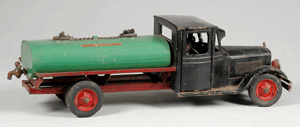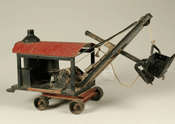|
Cowan's
Corner
Buddy L Toys: King of the Road
By Wes Cowan
The history of toy automobiles began with the invention of the horseless
carriage, and the love affair continues today. According to historians, getting
boys "hooked" on toy cars is one way to ensure customers for the real thing down
the road.
One of the most successful lines of toy vehicles ever is Buddy L,
introduced by Fred Lundahl and named for his son. The Moline Pressed Steel
Company in Moline, Ill., began making the model vehicles in 1921 with the same
heavy-gauge steel that they used in the manufacturing of parts for automobiles
and trucks. The immediate and soaring popularity of these sturdy and durable
toys resulted in Moline Steel shifting exclusively to the models within a few
years.
|

|
Buddy L Tanker Truck
ca. 1930s, in original black, green and red paint with
chrome details and original decals, 25 in. long; $3,105; Feb. 2005.
|
Buddy L produced a wide variety of vehicles, from trains and
construction equipment to delivery and emergency vehicles to Ford cars and
trucks. All had moving parts, some had removable cargo, and a few were very
elaborate, including features such as working hydraulics. The early vehicles
averaged from 20 to 26 inches and were sturdy enough for a child to ride. This
indoor/outdoor utility insured Buddy L a place in toy vehicle history.
Before
Buddy L, most toy vehicles were made of cast iron or wood, but Buddy L's success
with steel spawned competition. Companies such as Keystone, Kingsbury, Structo
and Sturdy made heavy-gauge vehicles, while Acme, A.C. Gilbert, Girard and
Kingsbury produced lighter-gauge versions. During World War II, the need for
steel for the war effort meant finding other materials, so Buddy L produced wood
vehicles during those years. After the war, vehicle size decreased and Buddy L
experimented with plastics, but quickly returned to metal fabrication, although
in lighter-gauge materials. In the 1970s, the company was sold to a Japanese
firm that began incorporating increasing amounts of plastics into the vehicles.
Today, the models are made in China and are nearly all plastic.
While all
Buddy L toys from the 1920s to the 1960s are collectible, most desirable are the
heavy-gauge pre-war models. These can command prices from a few hundred to
several thousand dollars. The early trains produced by Buddy L are among the
sturdiest of all American toy trains and routinely sell in a higher price range.
Vehicles produced by this icon of toy manufacturing promise to retain their
value for years to come.
 About the Author: Wes Cowan is founder and owner
of Cowan's Auctions, Inc. in Cincinnati, Ohio. An internationally recognized
expert in historic Americana, Wes stars in the PBS television series History
Detectives and is a featured appraiser on the Antiques Roadshow. He can be
reached via email at info@cowanauctions.com. Article research by Ted Sunderhaus. About the Author: Wes Cowan is founder and owner
of Cowan's Auctions, Inc. in Cincinnati, Ohio. An internationally recognized
expert in historic Americana, Wes stars in the PBS television series History
Detectives and is a featured appraiser on the Antiques Roadshow. He can be
reached via email at info@cowanauctions.com. Article research by Ted Sunderhaus.
|

Buddy L Improved Steam Shovel with Claw, ca. 1929-30, original paint with
chromed-steel details and decals, 14 in. high x 21 in. long; $805; Feb. 2005.
|